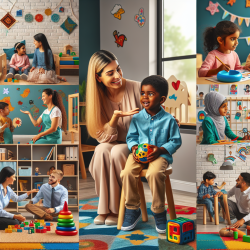As a practitioner dedicated to creating positive outcomes for children with autism, staying informed about the latest research and implementing evidence-based practices is crucial. The study "Cross-Cultural Content Validity of the Autism Program Environment Rating Scale in Sweden" provides valuable insights into assessing and improving preschool environments for children with Autism Spectrum Disorder (ASD).
The Autism Program Environment Rating Scale-Preschool/Elementary (APERS-PE) was initially developed in the United States to evaluate the quality of educational programs for children with ASD. This tool has been successfully adapted to various cultural contexts, including Sweden, where it is known as the APERS-P-SE.
The Swedish adaptation of the APERS-PE involved a meticulous process of translation and cultural modification to ensure its relevance and applicability in Swedish preschools. Independent experts evaluated the content validity of the APERS-P-SE, confirming its high cross-cultural validity. This adaptation highlights both the similarities and differences between American and Swedish preschool systems, particularly in their approach to early ASD intervention.
Key Findings from the Study
- High Content Validity: The APERS-P-SE demonstrated high content validity at the item, subdomain, domain, and total score levels. This indicates that the tool is well-suited for assessing the quality of preschool programs for children with ASD in Sweden.
- Need for Quality Control: The study underscores the necessity of quality control in Swedish preschools. The APERS-P-SE can serve as a valuable instrument for ensuring that these environments meet the needs of children with ASD.
- Comprehensive Assessment: The APERS-P-SE provides a thorough evaluation of various aspects of the preschool environment, including learning climate, staff competence, and physical setup. This comprehensive approach is essential for identifying areas of improvement.
- Cultural Adaptation: Significant modifications were made to fit the APERS-PE to the Swedish context. For example, the Swedish version focuses solely on preschool settings, reflecting the conceptual differences between preschool and elementary education in Sweden.
Implementing the APERS-P-SE in Your Practice
For practitioners working in preschool settings, the APERS-P-SE offers a structured method for evaluating and enhancing the quality of educational programs for children with ASD. Here are some steps to consider:
- Training: Ensure that you and your team are trained in administering the APERS-P-SE. This training will help you accurately assess the various domains and subdomains of the preschool environment.
- Comprehensive Evaluation: Use the APERS-P-SE to conduct a thorough evaluation of your preschool program. This includes observing classroom activities, reviewing Individual Education Plans (IEPs), and interviewing parents and staff.
- Action Plans: Based on the findings from the APERS-P-SE assessment, develop action plans to address areas of improvement. This may involve enhancing staff training, modifying the physical environment, or implementing new teaching strategies.
- Continuous Monitoring: Regularly use the APERS-P-SE to monitor changes in program quality over time. This ongoing assessment will help you ensure that your preschool environment continues to meet the needs of children with ASD.
Encouraging Further Research
While the APERS-P-SE provides a robust framework for assessing preschool environments, further research is needed to explore its full potential. Practitioners are encouraged to contribute to this body of knowledge by conducting their own studies and sharing their findings. This collaborative effort will help refine the APERS-P-SE and ensure that it remains a valuable tool for improving educational outcomes for children with ASD.
To read the original research paper, please follow this link: Cross-Cultural Content Validity of the Autism Program Environment Rating Scale in Sweden.










